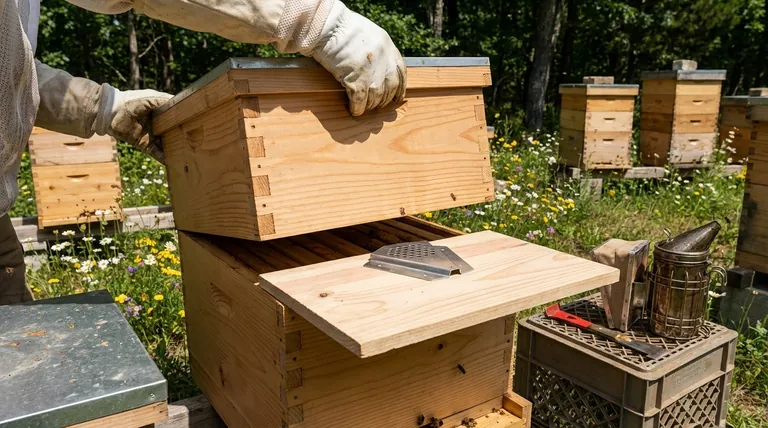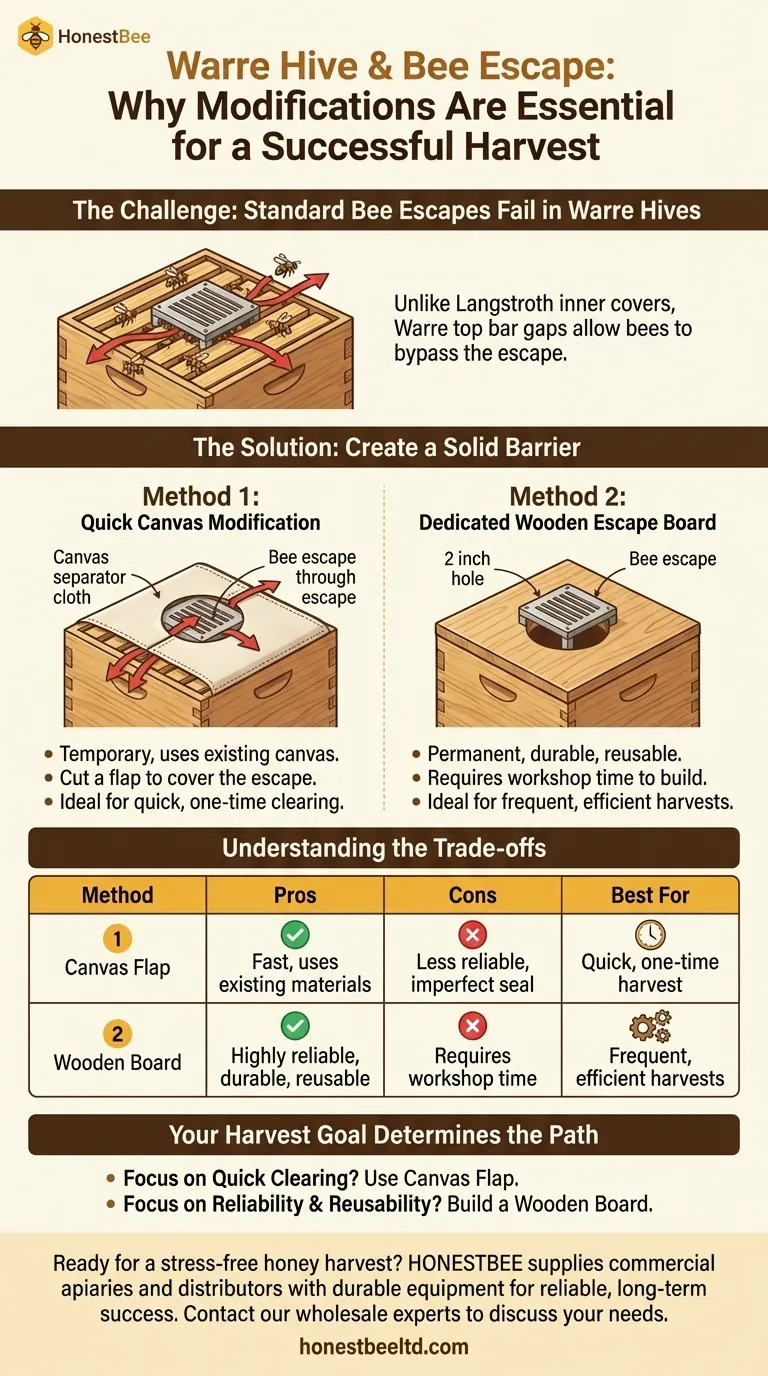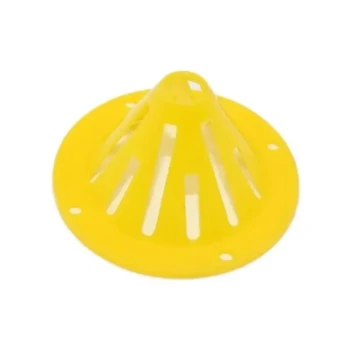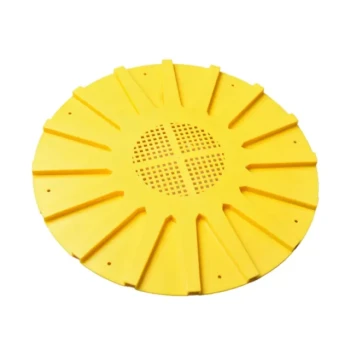To use a bee escape in a Warre hive, you must create a solid barrier that forces the bees through the one-way exit. Because a Warre hive uses top bars instead of framed inner covers, a standard bee escape placed directly on the bars will be ineffective. You can either temporarily modify the hive's canvas separator cloth or, for a more reliable solution, construct a dedicated wooden escape board.
The core challenge in a Warre hive is preventing bees from simply walking around the bee escape. Your modification, whether a temporary canvas flap or a permanent wooden board, must create a solid "inner cover" that seals the gaps between top bars, leaving the escape as the only way down.

Why a Standard Bee Escape Fails in a Warre
A bee escape is a simple one-way valve. To work, it must be the only route available for the bees. The unique design of a Warre hive makes this difficult without modification.
The Problem of Top Bar Gaps
Unlike a Langstroth hive, which uses a solid inner cover, a Warre hive has a stack of boxes with open top bars. When you place a bee escape directly on these bars, there are numerous gaps between them.
Bees Will Bypass the Escape
Bees are ruthlessly efficient. If they can walk through the gaps between the top bars to get down into the hive, they will ignore the more complex path through the bee escape. This renders the device useless.
Two Methods for an Effective Modification
To solve this, you need to create a solid surface to mount or cover the bee escape. There are two primary approaches.
Method 1: The Quick Canvas Modification
This is a temporary, field-expedient solution using the existing canvas cover that sits atop your upper hive box.
- Place your bee escape in the center of the top bars of the box below the one you wish to harvest.
- Take your canvas separator cloth and cut a 'C' shaped flap in its center, just large enough to cover the bee escape.
- Lay the canvas over the top bars, with the flap pushed down over the bee escape. This canvas acts as a barrier, forcing the bees to find the entrance to the escape.
Method 2: The Dedicated Escape Board
This is a more permanent and reliable solution that creates a reusable piece of equipment, similar to a Langstroth inner cover.
- Obtain a solid, flat piece of wood or other rigid material cut to the interior dimensions of your hive (typically around 14x14 inches or 355x355mm).
- Drill a 2-inch (50mm) hole in the exact center of the board.
- Mount your bee escape over this hole on one side of the board.
Critical Placement and Orientation
Regardless of the method, correct placement is essential. The escape board or modified canvas must be placed between the honey box to be harvested and the hive body below it.
The escape itself must be oriented so the exit faces downward into the main hive cluster. This allows bees to leave the honey box but prevents them from re-entering.
Understanding the Trade-offs
Each method has clear advantages and disadvantages. Your choice depends on your goals and how often you plan to use this technique.
The Canvas Flap Method
Pros: It requires no extra equipment and can be done immediately with just a knife.
Cons: It can be less "bee-proof" if the canvas doesn't lay perfectly flat. Bees may propolize the canvas to the escape, making removal messy. The seal is often imperfect.
The Wooden Board Method
Pros: This is the most effective and reliable method. It creates a perfect seal, is durable, and can be used for every harvest year after year.
Cons: It requires some initial workshop time to build and is another piece of beekeeping equipment you must store.
Making the Right Choice for Your Harvest
Use your goal to determine the best path forward for a calm and successful honey harvest.
- If your primary focus is a quick, one-time clearing: The canvas flap method is a workable solution that gets the job done without building new equipment.
- If your primary focus is reliability and reusability for future harvests: Building a dedicated wooden escape board is a small investment that will pay dividends in efficiency and effectiveness.
With the correct modification, a bee escape is an invaluable tool for any Warre beekeeper, ensuring a peaceful separation of bees from their honey.
Summary Table:
| Method | Pros | Cons | Best For |
|---|---|---|---|
| Quick Canvas Modification | Fast, uses existing materials | Less reliable, imperfect seal | A quick, one-time harvest |
| Dedicated Escape Board | Highly reliable, durable, reusable | Requires initial workshop time | Frequent, efficient harvests |
Ready for a stress-free honey harvest? HONESTBEE supplies commercial apiaries and distributors with the durable beekeeping equipment needed for reliable, long-term success. From high-quality materials to build your own escape boards to complete harvesting solutions, we support your operation's growth. Contact our wholesale experts today to discuss your needs.
Visual Guide

Related Products
- Heavy Duty Metal Corner Bee Escape for Reliable Hive Clearing
- Professional Durable Two-Piece Plastic Bee Escape
- Circular Labyrinth Bee Escape for Efficient Hive Management
- HONESTBEE Wooden Bee Escape Board with Triangle Mesh Design for Beekeeping
- Slatted Porter Style Bee Escape for Rapid Hive Clearing
People Also Ask
- What should be considered when choosing a Triangular Escape Board? Ensure a Proper Fit for a Calm Harvest
- What are the different types of bee escape boards? Choose the Right One for a Stress-Free Honey Harvest
- How should the Bee Escape Board be placed under the honey supers? Master the Correct Orientation for a Calm Harvest
- What issue occurred with one of the hives during the honey harvest? Feral Comb Blocked the Bee Maze
- What is the effectiveness of the Bee Escape Board? Achieve a Calm, 95% Bee-Free Honey Harvest



















